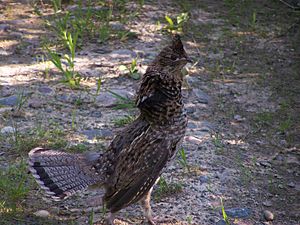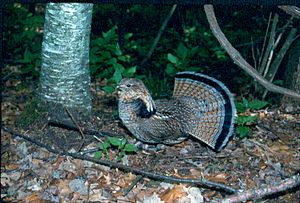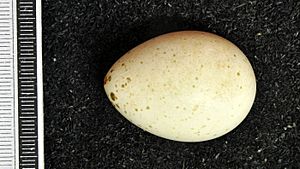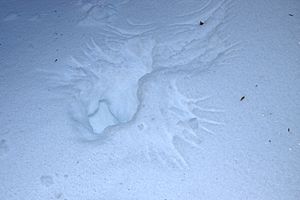Ruffed grouse facts for kids
Quick facts for kids Ruffed grouse |
|
|---|---|
 |
|
| Female ruffed grouse in Algonquin Provincial Park | |
| Conservation status | |
| Scientific classification | |
| Genus: |
Bonasa
|
| Species: |
umbellus
|
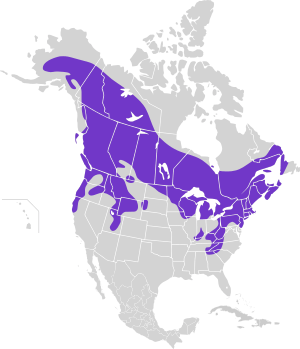 |
|
| Synonyms | |
|
|
The ruffed grouse (Bonasa umbellus) is a medium-sized bird found in forests. You can find them from the Appalachian Mountains all the way across Canada to Alaska. These birds do not migrate, meaning they stay in the same area all year. It is the only type of bird in its group, called Bonasa.
Sometimes, people mistakenly call the ruffed grouse a "partridge". However, partridges are different birds. The ruffed grouse is also sometimes confused with the grey partridge. Grey partridges live in open fields, while ruffed grouse prefer woodlands.
The ruffed grouse is the official state bird of Pennsylvania in the United States.
Contents
What is a Ruffed Grouse?

The ruffed grouse, known scientifically as Bonasa umbellus, was first described in 1766. This was done by a famous scientist named Carl Linnaeus. He first put it in a group with other grouse from Europe.
Later, in 1819, a British naturalist named John Francis Stephens gave it the name Bonasa. "Ruffed grouse" is the best name for this bird. This is because other names like "partridge" or "pheasant" belong to different birds. Some people also call them "drummer" or "thunder-chicken" because of a special sound they make.
Types of Ruffed Grouse: Subspecies
There are 14 different types, or subspecies, of ruffed grouse. These subspecies are slightly different depending on where they live. They all belong to the same species, but have small variations.
- B. u. yukonensis Grinnell, 1916
- B. u. umbelloides (Douglas, 1829)
- B. u. labradorensis Ouellet, 1991
- B. u. castanea Aldrich & Friedmann, 1943
- B. u. affinis Aldrich & Friedmann, 1943
- B. u. obscura Todd, 1947
- B. u. sabini (Douglas, 1829)
- B. u. brunnescens Conover, 1935
- B. u. togata (Linnaeus, 1766)
- B. u. mediana Todd, 1940
- B. u. phaios Aldrich & Friedmann, 1943
- B. u. incana Aldrich & Friedmann, 1943
- B. u. monticola Todd, 1940
- B. u. umbellus (Linnaeus, 1766)
Physical Appearance: What Do They Look Like?
These birds are chunky and medium-sized. They usually weigh between 450 and 750 grams (about 1 to 1.6 pounds). They are about 40 to 50 centimeters (16 to 20 inches) long. Their short, strong wings can spread from 50 to 64 centimeters (20 to 25 inches) wide.
Ruffed grouse come in two main color types, called morphs: grey and brown.
- Grey morph: These birds have grey-brown heads, necks, and backs. Their chest is light with stripes. They have a lot of white on their belly and sides. Their throat is often lighter. The tail is brownish-grey with stripes and a wide black band near the end.
- Brown morph: These birds have the same tail color and pattern. However, the rest of their feathers are much more brown. This makes them look more uniform. Birds in warmer and more humid places tend to be browner.
Both male and female ruffed grouse have ruffs on the sides of their necks. They also have a crest of feathers on top of their heads. This crest can sometimes lie flat. Males and females look very similar in size and markings. This makes them hard to tell apart.
One way to tell them apart is by their tail band. Females often have a broken black band on their tail. Males usually have an unbroken tail band. However, sometimes this can be the opposite. Another clue is the feathers on their rump. If a rump feather has one white dot, it's likely a female. If it has more than one white dot, it's probably a male.
Ecology: Where Ruffed Grouse Live and What They Eat
Like most grouse, these birds spend most of their time on the ground. They especially like mixed woodlands with lots of aspen trees. Ruffed grouse look for food on the ground or in trees.
They are omnivores, meaning they eat both plants and insects. Their diet includes buds, leaves, berries, seeds, and insects. They can eat many different kinds of food. This helps them live in many different places.
One nature writer, Don L. Johnson, said that a ruffed grouse's diet is very varied. He even found a live salamander in one grouse's stomach. Another time, he found a small snake. This shows how adaptable their diet is.

Hunting Ruffed Grouse
Hunting ruffed grouse is popular in the northern and western United States, and in Canada. Hunters often use shotguns. Sometimes, dogs are used to help find the birds. Hunting ruffed grouse can be quite difficult.
This is because grouse spend most of their time in thick bushes and young pine forests. Their camouflage makes them very hard to see when they are looking for food. When there is enough snow, they will burrow under it for warmth.
Like other forest animals, ruffed grouse make trails through the underbrush. You can often find these trails by looking for feathers on the ground or on twigs. Hunting these birds requires good hearing and lots of energy. You will be walking and listening for them in the leaves.
Grouse often look for gravel and clover along roads. They do this in the early morning and late afternoon. These are good places to walk if you want to find them. Grouse also use sandy roads to dust their feathers. This helps them get rid of skin pests. You can spot dusting sites by disturbed soil and feathers. Birds return to these spots in the late afternoon to dust themselves, socialize, and find mates.
Minnesota is the state that produces the most ruffed grouse in the U.S.
Behavior: How Ruffed Grouse Act
The ruffed grouse has a special way of attracting a mate. Unlike other grouse, it does not use calls. Instead, it makes a sound called "drumming." This drumming is a fast beating of its wings. It creates a low sound that starts slow and then speeds up. It sounds like "thump ... thump ... thump..thump-thump-thump-thump." You can hear this sound from far away, even in thick woods.
Ruffed grouse usually spend their time quietly on the ground. If they are surprised, they might suddenly fly up. When they take off, they beat their wings very loudly. In winter, they dig into the snow to stay warm. If you get too close, they might burst out of the snow.
The number of ruffed grouse goes up and down in a regular pattern. Scientists call this the "grouse cycle." This cycle happens no matter how much or how little hunting there is. Even though there's a historical cycle, populations have been decreasing in some areas like Pennsylvania. Losing their habitat is a problem for these birds. Also, a disease called West Nile virus has been causing more grouse to die.
See also
 In Spanish: Grévol engolado para niños
In Spanish: Grévol engolado para niños



